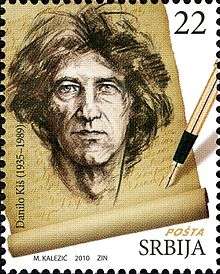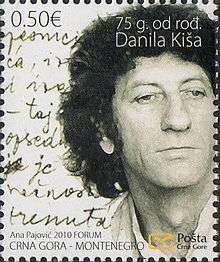Danilo Kiš
| Danilo Kiš | |
|---|---|
 Danilo Kiš on a 2010 Serbia stamp | |
| Native name | Данило Киш |
| Born |
22 February 1935 Subotica, Danube Banovina, Kingdom of Yugoslavia |
| Died |
15 October 1989 (aged 54) Paris, France |
| Resting place | Belgrade's New Cemetery |
| Occupation | Novelist, short story writer, poet |
| Language | Serbo-Croatian |
| Alma mater | University of Belgrade |
| Spouse | Mirjana Miočinović (m. 1962–81) |
Danilo Kiš (Serbian Cyrillic: Данило Киш; 22 February 1935 – 15 October 1989) was a novelist, short story writer and poet who wrote in Serbo-Croatian. A member of the Serbian Academy of Sciences and Arts,[1] Kiš was influenced by Bruno Schulz, Vladimir Nabokov, Jorge Luis Borges, Ivo Andrić and Miroslav Krleža,[2] among other authors. His most famous works include A Tomb for Boris Davidovich and The Encyclopedia of the Dead.
Life and work

Kiš was born in Subotica, Danube Banovina, Kingdom of Yugoslavia (now Serbia). He was the son of Eduard Kiš (Hungarian: Kis Ede), a Hungarian-speaking Jewish railway inspector, and Milica (née Dragićević) from Cetinje (now Montenegro).[3] His father was born in Austria-Hungary with the surname Kon, but changed it to Kis as part of Magyarization, a widely implemented practice at the time. During the Second World War, Danilo's father along with several other family members, were killed in various Nazi camps. His mother took him and his older sister Danica to Hungary for the duration of the war. After the end of the war, the family moved to Cetinje, Yugoslavia, where Kiš graduated from high school in 1954.
Kiš studied literature at the University of Belgrade, and graduated in 1958 as the first student to be awarded a degree in comparative literature. He was a prominent member of the Vidici magazine, where he worked until 1960. In 1962 he published his first two novels, Mansarda and Psalam 44. For his 1973 novel Peščanik (Hourglass), Kiš received the prestigious NIN Award, but returned it a few years later due to a political dispute. During the following years, he received an array of national and international awards for his prose and poetry.
Kiš lived in Belgrade until the last decade of his life, when he lived in Paris as well as Belgrade. For a number of years he worked as a lecturer elsewhere in France. He was married to Mirjana Miočinović from 1962 to 1981. After their separation, he lived with Pascale Delpech until his early death from lung cancer in Paris.
A film based on Peščanik (Fövenyóra), directed by Hungarian director Szabolcs Tolnai, was finished in 2008.[4] In May 1989, with his friend, director Aleksandar Mandić, Kiš made the four-episode TV series Goli Život about the lives of two Jewish women. The shooting took place in Israel. The program was broadcast after his death, in the spring of 1990, and was his last work.
Kiš's work was translated into English only in a piecemeal fashion, and many of his important books weren't available in English until the 2010s, when Dalkey Archive began releasing a selection of titles, including A Tomb for Boris Davidovich and Garden, Ashes;[5] in 2012, Dalkey released The Attic, Psalm 44, and the posthumous collection of stories The Lute and the Scars,[6] capably translated by John K. Cox.[7] These publications completed the process of "the Englishing of Kiš's fiction",[7] allowing the possibility of what Pete Mitchell of Booktrust called a resurrection of Kiš.[5]
Style and themes
Kiš was influenced especially by Jorge Luis Borges: he had been accused of plagiarizing Borges (and James Joyce) in A Tomb for Boris Davidovich, which prompted a "scathing response" in The Anatomy Lesson (1978),[8] and the influence of Borges is recognized in The Encyclopedia of the Dead.[9] From Bruno Schulz, the Polish writer and prose stylist, Kiš picked up "mythic elements" for The Encyclopedia of the Dead, and he reportedly told John Updike that "Schulz is my God".[10]
Branko Gorjup sees two distinct periods in Kiš's career as a novelist. The first, which includes Psalm 44, Garden, Ashes, and Early Sorrows, is marked by realism: Kiš creates characters whose psychology "reflect[s] the external world of the writer's memories, dreams, and nightmares, or his experiences of the time and space in which he lives". The worlds he constructed in his narratives, while he distanced himself from pure mimesis, were still constructed to be believable. The separation from mimesis he sought to achieve by a kind of deception through language, a process intended to instill "'doubts' and 'trepidations' associated with a child's growing pains and early sorrows. The success of this 'deception' depended upon the effect of 'recognition' on the part of the reader". The point, for Kiš, was to make the reader accept "the illusion of a created reality".[11]
In those early novels, Kiš still employed traditional narrators and his plots unfolded chronologically, but in later novels, beginning with Hourglass (the third volume of the "Family Cycle", after Garden, Ashes and Early Sorrows), his narrative techniques changed considerably and traditional plotlines were no longer followed. The role of the narrator was strongly reduced, and perspective and plot were fragmented: in Hourglass, which in Eduard Scham portrayed a father figure resembling the author's, "at least four different Schams with four separate personalities" were presented, each based on documentary evidence.[11] This focus on the manipulation and selection of supposed documentary evidence is a hallmark of Kiš's later period, and underlies the method of A Tomb for Boris Davidovich, according to Branko Gorjup:
First, most of the plots in the work are derived or borrowed from already-existing sources of varied literary significance, some easily recognizable—for example, those extracted from Roy Medvedev and Karl Steiner—while others are more obscure. Second, Kiš employs the technique of textual transposition, whereby entire sections or series of fragments, often in their unaltered state, are taken from other texts and freely integrated into the fabric of his work.[11]
This documentary style places Kiš's later work in what he himself called a post-Borges period, but unlike Borges the documentation comes from "historically and politically relevant material", which in A Tomb for Boris Davidovich is used to denounce Stalinism. Unlike Borges, Kiš is not interested in metaphysics, but in "more ordinary phenomena";[11] in the title story of The Encyclopedia of the Dead, this means building an encyclopedia "containing the biography of every ordinary life lived since 1789".[12]
Bibliography
- Mansarda: satirična poema, 1962 (novel); translated as The Attic by John K. Cox (2008)
- Psalm 44, 1962 (novel); translated as Psalm 44 by John K. Cox (2012)
- Bašta, pepeo, 1965 (novel); translated as Garden, Ashes by William J. Hannaher (1975)
- Rani jadi: za decu i osetljive, 1970 (short stories); translated as Early Sorrows: For Children and Sensitive Readers by Michael Henry Heim (1998)
- Peščanik, 1972 (novel); translated as Hourglass by Ralph Manheim (1990)
- Po-etika, 1972 (essay)
- Po-etika, knjiga druga, 1974 (interviews)
- Grobnica za Borisa Davidoviča: sedam poglavlja jedne zajedničke povesti, 1976 (short stories); translated as A Tomb for Boris Davidovich by Duška Mikić-Mitchell (1978)
- Čas anatomije, 1978 (book-essay about writing and politics in the Balkans)
- Noć i magla, 1983 (drama) translated as Night and Fog: The Collected Dramas and Screenplays of Danilo Kiš by John K. Cox (2014)
- Homo poeticus, 1983 (essays and interviews); translated as Homo Poeticus: Essays and Interviews by Ralph Manheim, Michael Henry Heim, and Francis Jones (1995)
- Enciklopedija mrtvih, 1983 (short stories); translated as The Encyclopedia of the Dead by Michael Henry Heim (1989)
- Gorki talog iskustva, 1990 (interviews)
- Život, literatura, 1990 (interviews and essays)
- Pesme i prepevi, 1992 (poetry)
- Lauta i ožiljci, 1994 (short stories); translated as The Lute and the Scars by John K. Cox (2012)
- Skladište, 1995 (texts)
- Varia, 1995 (essays, articles and short stories)
- Pesme, Elektra, 1995 (poetry and an adaptation from the drama Elektra)
References
- ↑ "Member". Sanu.ac.rs. Retrieved 10 January 2014.
- ↑ Razgovor sa Danilom Kišom. youtube.com
- ↑ "Book Reviews | Dalkey Archive Press". Dalkeyarchive.com. 21 November 2013. Retrieved 10 January 2014.
- ↑ "Hourglass (2007)". IMDB. Retrieved 12 January 2014.
- 1 2 Mitchell, Pete (19 December 2012). "'As if he were convulsed, or laughing': resurrecting Danilo Kiš". Booktrust. Retrieved 9 January 2014.
- ↑ Sacks, Sam (24 August 2012). "Book Review: Psalm 44, The Attic, The Lute and the Scars". The Wall Street Journal. Retrieved 9 January 2014.
- 1 2 Robson, Leo (14 December 2012). "The Lute and the Scars by Danilo Kis – review". The Guardian. Retrieved 9 January 2014.
- ↑ Motola, Gabriel (1993). "Danilo Kiš: Death and the Mirror". The Antioch Review. 51 (4): 605–21. JSTOR 4612839.
- ↑ Vuletić, Ivana (2003). The Prose Fiction of Danilo Kiš, Serbian Jewish Writer: Childhood and the Holocaust. Edwin Mellen. p. 19. ISBN 9780773467774.
- ↑ Goldfarb, David A. (1994). "A Living Schulz: Noc wielkiego sezonu ('The Night of the Great Season')". Prooftexts. 14 (1): 25–47. JSTOR 20689381.
- 1 2 3 4 Gorjup, Branko (1987). "Danilo Kiš: From 'Enchantment' to 'Documentation'". Canadian Slavonic Papers. 29 (4): 387–94. JSTOR 40868819.
- ↑ Power, Chris (2 August 2012). "A brief survey of the short story part 42: Danilo Kiš". The Guardian. Retrieved 16 December 2013.
External links
| Wikimedia Commons has media related to Danilo Kiš. |
- A dedicated website (in Serbian)
- Translated works by Danilo Kiš
- An essay by Aleksandar Hemon
- An interview
- Danilo Kiš' personal library on LibraryThing
- "A Conversation with Danilo Kis" by Brendan Lemon, a 1984 interview
- www.danilokis.org